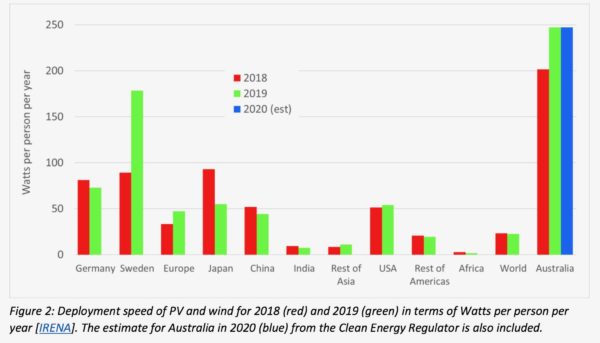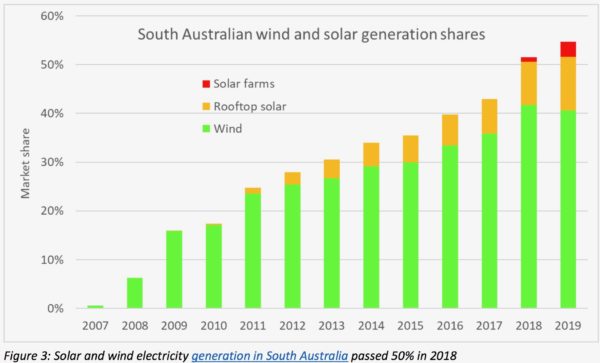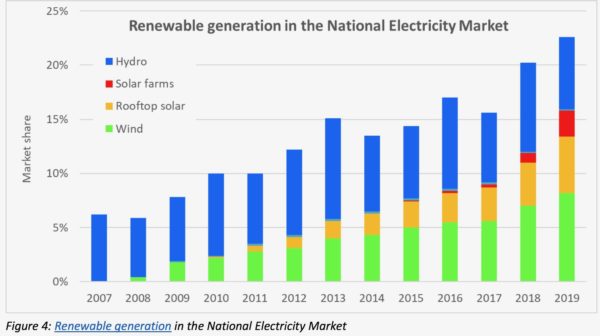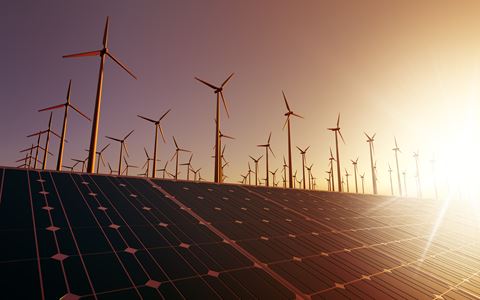According to recently published numbers from the Clean Energy Regulator and new analysis from the Australian National University (ANU), Australia is still the world leader in per capita roll out of solar and wind energy generation.
Despite revelations from the Clean Energy Council that the number of large-scale renewable energy projects committed in the second quarter of 2020 fell dramatically, the Clean Energy Regulator (CER) remains confident that the total additional delivered capacity for new solar and wind in 2020 will reach approximately 6.3 GW, including 3.4 of utility-scale projects and 2.9 GW of installed rooftop solar.

“This brings the total to 18 GW over 2018-20,” said the paper’s co-author Professor Andrew Blakers, keeping Australia in a firm lead in the per capita renewable deployment ranks.
Raising the roof
While experts such as Cornwall Insight Australia consultant Ben Cerini have warned that solar installers are likely to face a severe short-term market downturn as a result of the Covid-19 pandemic, so far the uptake of rooftop PV has remained robust.
Indeed, CER has had to adjust its estimate of 2.7 GW of rooftop solar PV for 2020 as that figure is now likely to reach 2.9 GW. Australia now has approximately 12 GW of rooftop solar installed, with almost 30% of suitable dwellings having installed a solar system.
Worldwide, people are beginning to realise that the 21st century will likely prove the century of biological epidemics, as the 20th century was the century of ideological epidemics. With this realisation, we are starting to reevaluate what the real necessities of our survival are. When a pandemic takes the breath out of the global economy, leaving us stuck at home with reduced access to income and increasing electricity bills, people are quickly learning to appreciate the vital importance of self-sufficiency, and, therefore, the necessity of generating your own energy.
As the great 20th-century logician Bertrand Russell once noted, “nothing finite is self-subsistent.” This is to say, only the infinite, the renewable, is self-subsistent. Down to the level of the individual, Covid-19 has shown us just how precarious and uncivilised a dependence on exterior and finite resources really is.
South Australian supremacy
With the notable exception of Tasmania, South Australia (SA) is the renewable powerhouse of Australia. 53% of SA’s generated energy comes from solar and wind, a rapid uptake that would be less impressive if it weren’t also sustainable.

Bottleneck
This is all good news, says Professor Andrew Blakers, “However…we urgently need more investment to remove bottlenecks in deployment of further renewables.”
Despite the CER reporting that there a strong pipeline of new utility-scale wind and solar projects until at least 2022, Blakers says that stronger transmission investment is desperately needed to free up grid congestion and get new solar and wind from rural locations to the cities.
“An effective way to do this is to upgrade transmission lines from rural Renewable Energy Zones, such as those recently announced in NSW and Queensland, to our cities,” said Blakers. “While our governments have been slow to act on transmission, if the Federal and state governments make determined efforts to rapidly resolve these bottlenecks, we can get ahead of the solar and wind construction curve instead of lagging behind it.”
According to analysts Wood Mackenzie, despite a renewables project pipeline in the NEM of 67 GW (comprising 6 GW under construction and 61 GW in announced projects), the conversion rate of these projects is achingly slow, sometimes disastrously so.
“Looking beyond 2021, new investment is drying up,” Wood Mackenzie principal analyst Robert Liew said. “Australia needs a well-defined road map to address investments in grid infrastructure if renewables growth is to continue.”
The ANU study’s authors noted that the Australian Energy Market Operator’s (AEMO) 2020 Integrated System Plan (ISP) is the right pathway to the changes and upgrades Australia’s electricity system needs in order to incorporate the potentially omnipotent renewable energy Australia possesses. Blakers and his colleagues argue that the ISP’s ambitious “Step Change” scenario, which posits an Australia in the late 2030s with 90% renewable energy, is remarkably achievable. In fact, the ANU analysis suggests Australia’s installation rates are already on the “Step Change” pathway: “It would therefore be prudent to model much more ambitious scenarios.”

ANU study co-author Associate Professor Matthew Stocks said that “Now is the time to plan to accelerate renewable deployment and electrification to decarbonise the entire economy.”
This content is protected by copyright and may not be reused. If you want to cooperate with us and would like to reuse some of our content, please contact: editors@pv-magazine.com.









Great to hear further evidence that state governments are circumventing
an incompetent federal government hell-bent on pushing fossil fuels!